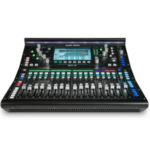Forums › Forums › dLive Forums › dLive feature suggestions › Metering on DCA faders
Tagged: dca, Signal Indicator
- This topic has 63 replies, 26 voices, and was last updated 6 months ago by
Brian.
-
AuthorPosts
-
2019/03/23 at 2:37 pm #82920
 dcongdonParticipant
dcongdonParticipantIf accurate metering is a concern, I could see some benefit to having a single LED illuminate to show when audio is present.
2019/03/23 at 2:39 pm #82921 SteffenRParticipant
SteffenRParticipantIf accurate metering is a concern, I could see some benefit to having a single LED illuminate to show when audio is present.
“signal present” and Peak detection would help on that, that’s true
2019/03/23 at 11:57 pm #82928 WolfgangParticipant
WolfgangParticipantI would also like the possibility of a clip recognition at the DCA.
We discussed here in a German forum whether there should be a level indicator on the DCA. Some colleagues would like to have that, I personally don’t miss it – but I wouldn’t resist it either.2019/03/24 at 7:29 am #82930Brendonp
ParticipantSo back in the analogue days when we had VCA’s there was no metering on the VCA at all.
However what we did get was a VCA MAX light on every channel to indicate when the VCA chip could not give any more leval to the channel.
Do we still need this, can the DCA cause a channel to clip?2019/03/30 at 12:44 am #83053 WolfgangParticipant
WolfgangParticipantthe idea of our colleagues refers primarily to events where a large number of channels are available.
When you mix an orchestra, you often have many channels in a DCA group.
Here it would be useful to have at least the loudest input signal in this group on the level meter to see if it gets hot somewhere.In contrast to earlier analog consoles, we can also listen to the DCA groups in the dLive. This is of course not a mix bus, but the signal is already present here, so a level meter should no longer be a witch’s work.
I find this idea, after some thinking, even good.2019/03/30 at 2:55 pm #83064 RaunoaParticipant
RaunoaParticipantHey!
I would also like to see, is there any signal in DCA metering. I have made many musicals with X32/M32 and this is good information to see, is signal up or not.
Some mode ideas for DCA metering:
A. Signal – shows only with one LED (green) that, is there any signal – DEFAULT
B. Hottest – shows hottest peaks
C. Avarage – shows avarage peaks (slower) – Avarage is not summing audio, just calc. by channel meters. (if this is possible and not take much CPU)2019/04/24 at 11:51 am #83503Joshua
ParticipantHad the same concern. Even if not the metering, At least some kind of indication that signal is there would be really helpful while working on large events.
2019/04/27 at 8:52 pm #83569Anonymous
InactiveCan anyone name a desk that has dca via MCA metering apart from the one named above. Just interested. Never come across it myself in o or twenty years of live mixing
Yamaha CL & QL for sure. Probably the M7 as well.
A&H should just implement it the same way Yamaha has. It’s a post-fade sum of signal levels from the channels assigned to that DCA. Extremely easy to implement in software.
2019/04/29 at 9:12 pm #83613 WolfgangParticipant
WolfgangParticipantListening to the DCA buses with PAFL has always been possible.
This signal could be evaluated for a level display, that would be enough.2019/05/01 at 6:31 pm #83634 RaunoaParticipant
RaunoaParticipantListening to the DCA buses with PAFL has always been possible.
Sorry, but you missing a point. I need to see 12 meters at a same time, not hiting PAFL.
2019/05/02 at 10:30 am #83637 SteffenRParticipant
SteffenRParticipantC. Avarage – shows avarage peaks (slower) – Avarage is not summing audio, just calc. by channel meters. (if this is possible and not take much CPU)
what you think what the meters do?
They measure a value, if you need to calculate a value for a bus, you have to sum the signals to calculate correctly
DCA metering wiLl not work in all cases, since you can control a channel with multiple DCA
so the desk has to calculate 24 DCA meterings, always…I would prefer a peak detection and signal present, that’s it what makes the most sense
A&H should just implement it the same way Yamaha has. It’s a post-fade sum of signal levels from the channels assigned to that DCA. Extremely easy to implement in software.
where did you get the information from?
2019/05/02 at 7:18 pm #83653 WolfgangParticipant
WolfgangParticipantSorry, but you missing a point. I need to see 12 meters at a same time, not hiting PAFL.
that’s correct.
but what i wanted to point out is the fact that the pick-up point in the DCAs is already there in principle, here “only” the level values have to be read out.
it is of course possible that you still have a lot of work to do in the background to program this accordingly. i don’t have any insight into which steps are necessary.
but it should be possible.2019/05/02 at 11:29 pm #83658 DavidCoParticipant
DavidCoParticipantMr.X: Read my post on the previous page. If I had a quid for every time someone said in an unqualified statement that something was “easy to implement”, I’d be a rich man.
I’m not sure what metering the “hottest” signal would tell the user, the level doesn’t mean anything useful. However I agree the peak LED is a totally different consideration. It could be analogous to the layer keys peaking, alerting the user something is wrong and requires investigation.
DC
2019/05/03 at 7:25 pm #83666 RaunoaParticipant
RaunoaParticipantI’m not sure what metering the “hottest” signal would tell the user, the level doesn’t mean anything useful. ….
If to use one DCA then of course this doesn’t mean anything useful. But when to use like 12 DCA-s on the same layer, then this will be very useful information for fast troubleshooting.
But it would be super if at least there is a signal LED.
2019/05/03 at 7:41 pm #83667Anonymous
InactiveMr.X: Read my post on the previous page. If I had a quid for every time someone said in an unqualified statement that something was “easy to implement”, I’d be a rich man.
Well, I’m afraid you’re not going to get rich this time. 🙂
Here’s the qualification: It’s much easier than the summing that happens when you PFL a DCA, because the audio doesn’t need to be summed as it would be for a PFL (summing the audio is a more complex function). Only the channel levels need to be added, which are available for all channels at all times (see the meter page). Just simple addition of the numbers that are the AFL levels of the channels, that’s it. I am a programmer, and integer sums are probably one of the simplest operations a computer can do. -
AuthorPosts
- You must be logged in to reply to this topic.